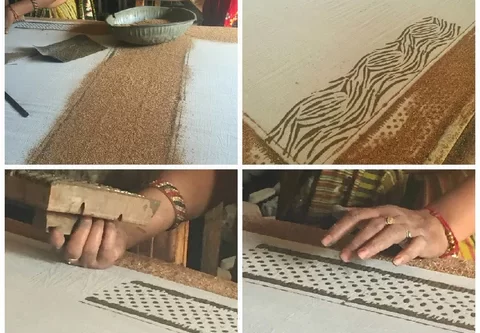Indian Block Print Fabric
Indian block print fabric is a traditional textile art form that has deep roots in the country’s rich cultural heritage. Renowned for its intricate designs, vibrant colors, and meticulous craftsmanship, block printing is a time-honored technique that has been passed down through generations. This ancient craft not only reflects the artistic prowess of Indian artisans but also serves as a testament to the nation’s historical trade and cultural exchanges.
History of Indian Block Printing –
The history of Indian block printing dates back over a thousand years, with evidence suggesting its existence during the ancient Indus Valley Civilization. However, it flourished and gained prominence during the Mughal era in the 16th century. The Mughal emperors, particularly Akbar, were patrons of the arts and played a pivotal role in the development of block printing. The craft evolved over the centuries, incorporating regional styles and influences, resulting in the diverse range of block print fabrics seen today.
Indian block print fabric is a traditional textile art form that has deep roots in the country’s rich cultural heritage. Renowned for its intricate designs, vibrant colors, and meticulous craftsmanship, block printing is a time-honored technique passed down through generations. This ancient craft not only reflects the artistic prowess of Indian artisans but also serves as a testament to the nation’s historical trade and cultural exchanges.

History of Indian Block Printing –
The history of Indian block printing dates back over a thousand years, with evidence suggesting its existence during the ancient Indus Valley Civilization. However, it flourished and gained prominence during the Mughal era in the 16th century. The Mughal emperors, particularly Akbar, were patrons of the arts and played a pivotal role in the development of block printing. The craft evolved over the centuries, incorporating regional styles and influences, resulting in the diverse range of block print fabrics seen today. In block print, so many types have printing methods.
- Bagru Prints
- Sanagneri Prints
- Jahota Prints
- Ajrakh Prints
- Bagh Prints
- Dabu Prints
- Indigo Prints
- Kalamkari Prints
Mainly Bagru prints are world-famous prints. The base color of Bagru print is off-white and these colors are prepared from natural dyes.
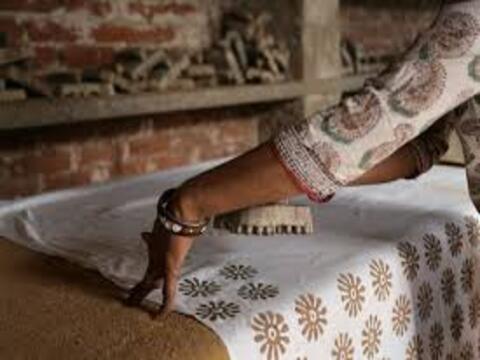
Bagru –
The “Chippas” of Bagru, India, who have been involved in the art of cloth printing for more than 100 years, practice a type of hand block printing known as “Bagru print” using natural colors. These Bagru prints are well-known around the world. [4] Unlike other prints, The Prints of Bagru uses a unique form of printing. The original printing technique makes use of wooden blocks. In this method, the chosen design is first etched on a wooden block, and then the design is replicated on the fabric using a carved block in the chosen color.

The Block Printing Process –
Block printing is a labor-intensive process that involves several stages, each requiring skill and precision. The process typically begins with the design creation, where skilled artisans carve intricate patterns onto wooden blocks. These blocks are usually made from teak or rosewood, chosen for their durability and fine grain.
Once the blocks are carved, they are dipped into natural dyes made from plants, minerals, and other organic sources. The skilled printer then meticulously stamps the fabric with the wooden blocks, creating a repetitive pattern that forms the design. The process is repeated across the entire length of the fabric, resulting in a seamless and beautifully patterned textile.

Regional Styles and Patterns –
One of the remarkable aspects of Indian block print fabric is the diversity of regional styles and patterns. Each region in India has its own unique block printing tradition, influenced by local culture, history, and aesthetics. For example, the vibrant and colorful designs of Jaipur’s block prints are distinct from the more subtle and earthy tones of Bagru prints. Sanganer, another region in Rajasthan, is renowned for its fine detailing and precision in block printing.
In Gujarat, the Ajrakh tradition produces geometric and floral patterns using natural dyes. Similarly, the intricate Kalamkari prints from Andhra Pradesh often depict mythological themes and stories. The art of block printing has spread to various parts of India, with each region contributing its special touch to this ancient craft.
Significance in Indian Culture –
Indian block print fabric holds immense cultural significance, not only as a symbol of artistic expression but also as a reflection of the country’s diverse cultural heritage. These textiles are used for various purposes, including clothing, home furnishings, and ceremonial decorations. Many traditional Indian garments, such as sarees, salwar kameez, and dupattas, feature elaborate block print designs, adding a touch of tradition and elegance.
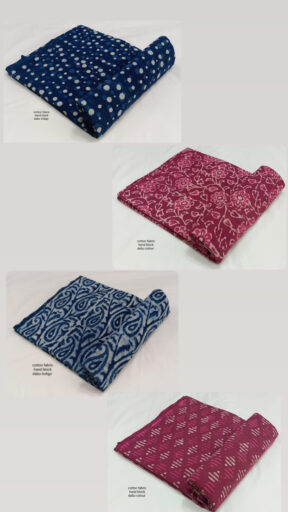
Challenges and Innovations –
While block printing has persevered through the centuries, it faces challenges in the modern era. Mass production and competition from machine-made textiles have threatened traditional artisans’ livelihoods. However, there has been a growing awareness and appreciation for handmade and sustainable products, leading to a renewed interest in traditional crafts like block printing.
Artisans and designers are also exploring innovative ways to incorporate block prints into contemporary fashion and home decor. Collaborations between traditional artisans and modern designers have resulted in unique and stylish creations that blend the old and the new.
Conclusion –
Indian block print fabric is more than just a textile; it is a testament to the country’s rich cultural tapestry and artistic heritage. The meticulous craftsmanship, vibrant colors, and diverse regional styles make it a cherished tradition that thrives in the face of modern challenges. As consumers increasingly value handmade and sustainable products, the future of Indian block printing looks promising, ensuring that this ancient art form remains an integral part of India’s cultural legacy.
The Block Printing Process –
Block printing is a labor-intensive process that involves several stages, each requiring skill and precision. The process typically begins with the design creation, where skilled artisans carve intricate patterns onto wooden blocks. These blocks are usually made from teak or rosewood, chosen for their durability and fine grain.
Once the blocks are carved, they are dipped into natural dyes made from plants, minerals, and other organic sources. The skilled printer then meticulously stamps the fabric with the wooden blocks, creating a repetitive pattern that forms the design. The process is repeated across the entire length of the fabric, resulting in a seamless and beautifully patterned textile.
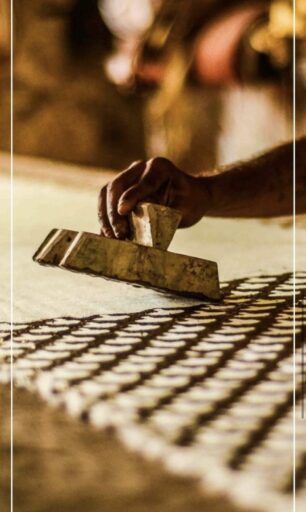
Regional Styles and Patterns –
One of the remarkable aspects of Indian block print fabric is the diversity of regional styles and patterns. Each region in India has its own unique block printing tradition, influenced by local culture, history, and aesthetics. For example, the vibrant and colorful designs of Jaipur’s block prints are distinct from the more subtle and earthy tones of Bagru prints. Sanganer, another region in Rajasthan, is renowned for its fine detailing and precision in block printing.
In Gujarat, the Ajrakh tradition produces geometric and floral patterns using natural dyes. Similarly, the intricate Kalamkari prints from Andhra Pradesh often depict mythological themes and stories. The art of block printing has spread to various parts of India, with each region contributing its special touch to this ancient craft.
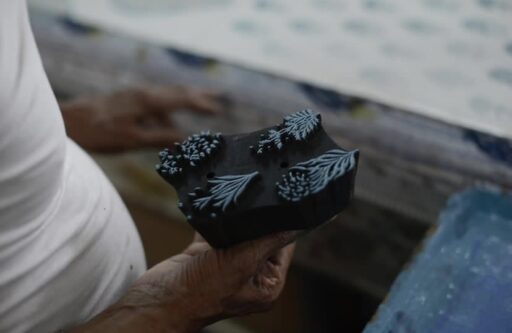
Significance in Indian Culture –
Indian block print fabric holds immense cultural significance, not only as a symbol of artistic expression but also as a reflection of the country’s diverse cultural heritage. These textiles are used for various purposes, including clothing, home furnishings, and ceremonial decorations. Many traditional Indian garments, such as sarees, salwar kameez, and dupattas, feature elaborate block print designs, adding a touch of tradition and elegance.
Challenges and Innovations –
While block printing has persevered through the centuries, it faces challenges in the modern era. Mass production and competition from machine-made textiles have threatened traditional artisans’ livelihoods. However, there has been a growing awareness and appreciation for handmade and sustainable products, leading to a renewed interest in traditional crafts like block printing.
Artisans and designers are also exploring innovative ways to incorporate block prints into contemporary fashion and home decor. Collaborations between traditional artisans and modern designers have resulted in unique and stylish creations that blend the old and the new.
Conclusion –
Indian block print fabric is more than just a textile; it is a testament to the country’s rich cultural tapestry and artistic heritage. The meticulous craftsmanship, vibrant colors, and diverse regional styles make it a cherished tradition that thrives in the face of modern challenges. As consumers increasingly value handmade and sustainable products, the future of Indian block printing looks promising, ensuring that this ancient art form remains an integral part of India’s cultural legacy.
FOLLOW US ON INSTAGRAM :



